
Operating excavating plants on a construction site is a high-stakes job. These powerful machines can be dangerous if not handled with care and respect. Following strict safety protocols is not just a good idea—it is a requirement to protect the operator, other workers, and the public. Understanding and implementing essential safety protocols for operating excavating plants is the foundation of a safe work environment. This article will walk you through the most critical safety measures.
Daily Pre-Operational Checks
Before you even start the engine, a daily inspection is a must. This pre-operational check is a quick but vital way to catch potential problems before they become major hazards. You should check all fluid levels, including hydraulic fluid, engine oil, and coolant, to ensure the machine runs smoothly and doesn’t overheat. Walk around the machine and inspect all hoses for any signs of leaks or damage, as a burst hydraulic hose can cause a serious injury. Also, look at the tracks or wheels for any wear, cracks, or other damage that could affect the machine’s stability and movement. This simple routine can prevent mechanical failures that might lead to an accident.
Site Safety on the Job
A safe work site requires clear communication and awareness from everyone. When an excavator is operating, proper signaling between the operator and ground workers is crucial. This includes using agreed-upon hand signals or radio communication to ensure everyone knows the machine’s next move. Spotters are also essential, especially when the operator’s view is limited. They guide the operator to ensure no one is in the machine’s swing radius. Furthermore, all workers on the site must wear high-visibility clothing. This simple step makes everyone more noticeable to the operator, especially in low light or dusty conditions, significantly reducing the risk of accidents.
Trench and Excavation Safety
Digging a trench or a deep hole comes with a significant risk of collapse, known as a cave-in. To prevent this, you must secure the walls of the excavation. One common method is shoring, which involves installing supports like timber or steel to hold the walls in place. Alternatively, you can use sloping or benching—cutting the walls back at a safe angle or creating a series of steps to prevent them from caving in. You must also be aware of the surrounding area. Avoid undermining nearby structures and always check for and mark the location of underground utility lines like gas, water, and electrical cables before you start digging. Hitting a utility line can have catastrophic consequences.
Operator Competence and Training
An excavator is a complex machine, and only trained and certified operators should ever be allowed to use one. Certification ensures that the operator has the necessary skills and knowledge to handle the machine safely. Just as important as initial certification is ongoing training. As technology advances and new equipment is introduced, operators must receive regular training to stay updated on new safety features and procedures. This commitment to continuous learning helps maintain high safety standards and reduces the risk of accidents caused by a lack of knowledge or skill.
References
- Occupational Safety and Health Administration (OSHA). (2023). Excavation and Trenching Safety. Retrieved from https://www.osha.gov/excavations
- Construction Industry Training Board (CITB). (2022). Health and Safety in Construction. Handbook.
For further information, you can find more guidelines on trench safety and other safety protocols from the National Institute for Occupational Safety and Health (NIOSH).
Leave a Reply